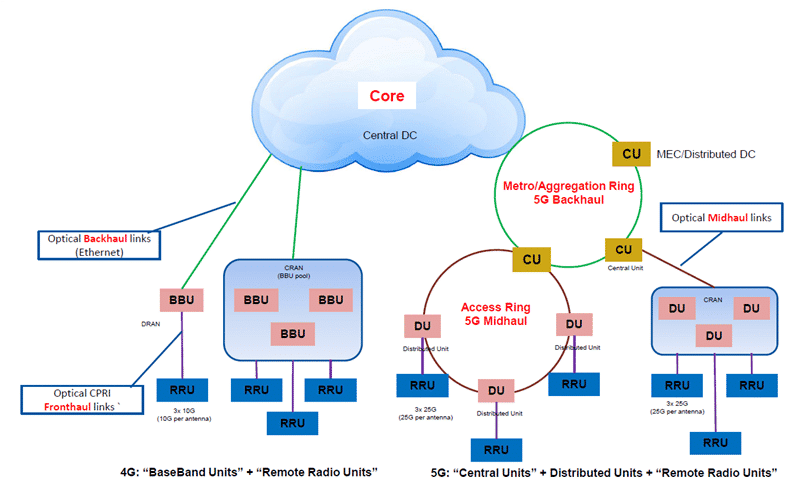
According to GSA statistics, as of the end of January 2019, 201 operators in 83 countries/regions tested, deployed or planned to deploy 5G. On April 3, South Korea’s three major operators and Verizon of the United States announced the opening of 5G commercial services for public users, and the 5G construction speeded up; on April 23, China Unicom announced the opening of 5G networks in 40 cities and officially released the 5G brand. It indicates that the domestic 5G construction is also accelerating.

Figure 4G/5G networking solution comparison
5G construction, bearer first, but the global operators’ 5G bearer solutions are different. Especially after the introduction of the concept of the middle pass, compatibility is considered whether to use independent networking, and the bearer scheme is more varied: for example, China Mobile adopts a new SPN network, China Telecom prefers to adopt M-OTN network, and China Unicom adopts IPRAN as the main mode of the bearer. Korean carriers and US carriers that are the first to be commercialized also use different bearer solutions. As is known, the complex bearer scheme will increase the number of corresponding 5G optical modules. However, according to the needs of the three major operators in China, there are certain contexts to be found.
In terms of speed, after the introduction of the eCPRI protocol standard, the pre-transmission 25G rate has become the standard of various equipment manufacturers. As a result, the rate of the bearer network will be considered according to the convergence ratio of each layer, and the 50G rate is the most The choice of cost performance, according to the development of the predecessor, there may be a module demand of 100G or even 200G rate.
In terms of fiber utilization efficiency, considering the difficulty of fiber laying, there is always a problem of tight fiber resources in some areas. Therefore, the BiDi module and even the WDM-based color light module will become a powerful complement to the requirements of the load module. The combination of speed, single/dual fiber and color light has resulted in a wide variety of 5G optical modules. Fortunately, the package form of the current mainstream optical module is basically based on QSFP28. Otherwise, the market for carrying optical modules will be more confusing.
As mentioned above, the 50G rate is the most cost-effective option for the middle pass, but from a module perspective, the 25G laser is the most popular rate choice for the industry chain. What should be done if there is a difference between the two? PAM4 technology solves this problem in a timely manner. It can double the amount of information transmitted per unit time through the algorithm of the electrical layer DSP at the same laser rate. Therefore, 50G PAM4 is based on a single 25G laser, and 50G rate signal transmission is realized by the electrical layer PAM4 technology. At present, the 50G PAM4 QSFP28 module is a typical requirement of the China Mobile network in the China Mobile SPN system. Guangxun Technology is the earliest optical module manufacturer in China to invest in 50G PAM4 LR/ER development. It is also involved in the discussion and formulation of China Mobile’s previous related standards. It is currently one of the few to provide a full range of 50G PAM4 products (10km single/dual fiber), 40km single/dual fiber) optical module manufacturers.
In addition, WDM color light modules are gaining more and more attention in 5G bearer solutions. Because in the foreign markets such as Japan and South Korea, the 4G era has begun to lay the bearer network of WDM solutions, and the continued selection of WDM modules in the 5G era is natural. At the same time, because the domestic 5G uses high-frequency signals, the coverage of the base station is small, and the number of 5G base stations will double that of the 4G era, which poses a great challenge for fiber laying. In terms of cost, although the cost of a separate module for WDM color light solutions is high, the cost of the overall solution will be more competitive.
Original Article Source http://www.qianjia.com/html/2019-05/06_335620.html